Compact Laser Modules with USB Connector

- 405 nm, 520 nm, 635 nm, or 639 nm Typical Center Wavelength
- Collimated Output
- Ø11 mm Compact, Electrically Isolated Housing
- Plug-and-Play, USB-Powered Operation
PL201
520 nm, 0.9 mW
Output Power
Sample beam profile of the PL202 USB laser module,
measured using a CCD beam profiler at a distance of 5 m.
USB Connector
Module Engraved with
Logo and Item #
Color at End of Module Corresponds to Laser's Spectral Color
Highly-Attenuating Electrical Filter Protects Against Power Supply Noise

Please Wait
| Quick Links |
|---|
| Laser Diode Modules |
| 0.9 mW |
| 4.5 mW |
| Accessories |
| Mounting Adapters |
| Kinematic Mount |
| Mounting Kit |
| 5 VDC Power Supply |
| USB Extension Cables |
| 5 VDC Battery Pack |
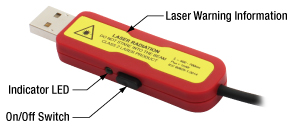
Click to Enlarge
USB Housing Features
| Webpage Features | |
|---|---|
| Clicking this icon opens a window that contains specifications and mechanical drawings. | |
Features
- 405 nm, 520 nm, 635 nm, or 639 nm Typical Center Wavelength
- 0.9 mW or 4.5 mW Typical Output Power
- Collimated Output
- Ø11 mm Compact, Electrically Isolated Housing
- Constant Power Mode Operation Using Built-In Photodiode Feedback
- USB Type-A Plug-and-Play Operation
- 1600 mm (63") Long Cable
- Mounting Accessories Available
- Compatible with DS5 Power Supply (Sold Separately)
Thorlabs' USB-equipped laser modules feature a typical output power of 0.9 mW (laser safety Class 2) at 405 nm, 520 nm, or 635 nm typical center wavelengths; or 4.5 mW (laser safety Class 3R) at 405 nm, 520 nm, or 639 nm typical center wavelengths. The collimated output has a Ø3 mm round beam profile at 50 mm from the housing. These modules offer single-spatial-mode output in a compact, electrically isolated cylindrical housing and are ideal for use as alignment lasers in optical systems. The lasers are driven in constant-power mode, with feedback from an internal photodiode used to maintain the optical output power. As these diodes are not thermally stabilized, their optical output power may fluctuate slightly during operation.
The USB Type-A connector on each laser module features a built-in, highly attenuating electrical filter to reduce noise for a more stable laser output. Also featured on the connector are a status LED, on/off switch, and laser warning information. A USB extension cable, sold below, can be used to provide access to the on/off switch in setups where the power supply connection is not readily accessible. We also offer these laser modules with bare wire leads for integration into OEM or industrial applications, and phono-jack equipped laser modules with collimated or adjustable-focus varieties.
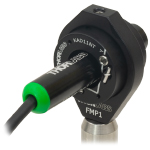
Click to Enlarge
PL201 Laser Module Held in a KAD11NT Unthreaded Kinematic Adapter and Mounted into an FMP1 Fixed Optic Mount
We recommend powering these lasers with our DS5 5 VDC power supply, which is sold separately below.
Mounting Options
The Ø11 mm housing is compatible with our line of optomechanical components through the use of various mounting adapters, as shown in the images to the right. Depending on the adapter chosen, these laser modules can be directly mounted into either internally SM1-threaded (1.035"-40) components or mechanics with a Ø1" bore. Further details on each adapter and its compatibility with our line of optomechanics can be found below. The PLK1(/M) Mounting Kit (shown in the photo to the right) includes a KM100T Threaded Kinematic Mount with an AD11F adapter, DS5 power supply, and Ø1/2" post hardware for common mounting applications.
Thorlabs also offers a Mini-Series kinematic mount for Ø11 mm laser diode modules (available below). This kinematic mount is among our smallest kinematic mounts available and features 4-40 (M3) taps for mounting onto our Ø6 mm Mini-Series Posts.
Laser Safety and Classification
Safe practices and proper usage of safety equipment should be taken into consideration when operating lasers. The eye is susceptible to injury, even from very low levels of laser light. Thorlabs offers a range of laser safety accessories that can be used to reduce the risk of accidents or injuries. Laser emission in the visible and near infrared spectral ranges has the greatest potential for retinal injury, as the cornea and lens are transparent to those wavelengths, and the lens can focus the laser energy onto the retina.
Safe Practices and Light Safety Accessories
- Laser safety eyewear must be worn whenever working with Class 3 or 4 lasers.
- Regardless of laser class, Thorlabs recommends the use of laser safety eyewear whenever working with laser beams with non-negligible powers, since metallic tools such as screwdrivers can accidentally redirect a beam.
- Laser goggles designed for specific wavelengths should be clearly available near laser setups to protect the wearer from unintentional laser reflections.
- Goggles are marked with the wavelength range over which protection is afforded and the minimum optical density within that range.
- Laser Safety Curtains and Laser Safety Fabric shield other parts of the lab from high energy lasers.
- Blackout Materials can prevent direct or reflected light from leaving the experimental setup area.
- Thorlabs' Enclosure Systems can be used to contain optical setups to isolate or minimize laser hazards.
- A fiber-pigtailed laser should always be turned off before connecting it to or disconnecting it from another fiber, especially when the laser is at power levels above 10 mW.
- All beams should be terminated at the edge of the table, and laboratory doors should be closed whenever a laser is in use.
- Do not place laser beams at eye level.
- Carry out experiments on an optical table such that all laser beams travel horizontally.
- Remove unnecessary reflective items such as reflective jewelry (e.g., rings, watches, etc.) while working near the beam path.
- Be aware that lenses and other optical devices may reflect a portion of the incident beam from the front or rear surface.
- Operate a laser at the minimum power necessary for any operation.
- If possible, reduce the output power of a laser during alignment procedures.
- Use beam shutters and filters to reduce the beam power.
- Post appropriate warning signs or labels near laser setups or rooms.
- Use a laser sign with a lightbox if operating Class 3R or 4 lasers (i.e., lasers requiring the use of a safety interlock).
- Do not use Laser Viewing Cards in place of a proper Beam Trap.
Laser Classification
Lasers are categorized into different classes according to their ability to cause eye and other damage. The International Electrotechnical Commission (IEC) is a global organization that prepares and publishes international standards for all electrical, electronic, and related technologies. The IEC document 60825-1 outlines the safety of laser products. A description of each class of laser is given below:
| Class | Description | Warning Label |
|---|---|---|
| 1 | This class of laser is safe under all conditions of normal use, including use with optical instruments for intrabeam viewing. Lasers in this class do not emit radiation at levels that may cause injury during normal operation, and therefore the maximum permissible exposure (MPE) cannot be exceeded. Class 1 lasers can also include enclosed, high-power lasers where exposure to the radiation is not possible without opening or shutting down the laser. |  |
| 1M | Class 1M lasers are safe except when used in conjunction with optical components such as telescopes and microscopes. Lasers belonging to this class emit large-diameter or divergent beams, and the MPE cannot normally be exceeded unless focusing or imaging optics are used to narrow the beam. However, if the beam is refocused, the hazard may be increased and the class may be changed accordingly. |  |
| 2 | Class 2 lasers, which are limited to 1 mW of visible continuous-wave radiation, are safe because the blink reflex will limit the exposure in the eye to 0.25 seconds. This category only applies to visible radiation (400 - 700 nm). |  |
| 2M | Because of the blink reflex, this class of laser is classified as safe as long as the beam is not viewed through optical instruments. This laser class also applies to larger-diameter or diverging laser beams. |  |
| 3R | Class 3R lasers produce visible and invisible light that is hazardous under direct and specular-reflection viewing conditions. Eye injuries may occur if you directly view the beam, especially when using optical instruments. Lasers in this class are considered safe as long as they are handled with restricted beam viewing. The MPE can be exceeded with this class of laser; however, this presents a low risk level to injury. Visible, continuous-wave lasers in this class are limited to 5 mW of output power. |  |
| 3B | Class 3B lasers are hazardous to the eye if exposed directly. Diffuse reflections are usually not harmful, but may be when using higher-power Class 3B lasers. Safe handling of devices in this class includes wearing protective eyewear where direct viewing of the laser beam may occur. Lasers of this class must be equipped with a key switch and a safety interlock; moreover, laser safety signs should be used, such that the laser cannot be used without the safety light turning on. Laser products with power output near the upper range of Class 3B may also cause skin burns. |  |
| 4 | This class of laser may cause damage to the skin, and also to the eye, even from the viewing of diffuse reflections. These hazards may also apply to indirect or non-specular reflections of the beam, even from apparently matte surfaces. Great care must be taken when handling these lasers. They also represent a fire risk, because they may ignite combustible material. Class 4 lasers must be equipped with a key switch and a safety interlock. |  |
| All class 2 lasers (and higher) must display, in addition to the corresponding sign above, this triangular warning sign. |  |
|
| Posted Comments: | |
Tom Dzelzainis
(posted 2024-03-14 10:48:46.983) Hi,
A great idea, but please change the usb connector. If the button and integrated circuit can be separated from the actucal usb connector, and the button placed some way up the cable, the product would be improved so much.
Many thanks,
Tom. hchow
(posted 2024-03-14 08:35:53.0) Dear Mr. Dzelzainis,
thank you for your feedback. I will be sure to let the developers know about your suggestion. Thanks again. Chun-Aun Tan
(posted 2024-02-08 17:45:22.37) May I know the coherence length or bandwidth of this laser? hchow
(posted 2024-02-08 11:42:56.0) Dear Mr. Tan, thank you for your enquiry. Unfortunately, we do not have any data with respect to the spatial coherence length for these laser modules. The temporal coherence length, however, is related to the spectral emission bandwidth. A typical spectrum for each module is shown in the spec sheet. Please note that these plots are typical only and will vary from unit to unit. In some cases, the resolution of the spectrometer/OSA is not sufficient to show the actual linewidth. Furthermore, the temperature of the CPS modules is not actively controlled and for some modules, you will see that temperature also affects mode distribution. Li-Ya Yeh
(posted 2023-11-06 15:59:59.503) Dear Sir,
I found the product from your internet page and would like to check with you, whether the laser light is polarized. If not, would you mind suggesting to me your other similar product? I am looking for a laser diode with polarized light, e.g. P-Pol light.
thanks
Best Regards
Li-Ya yeh dpossin
(posted 2023-11-08 04:58:38.0) Dear Li-Ya Yeh,
Thank you for your feedback. In general lasers provide a polarized output since this is an essential part of the laser process. However since the process is not entirely clean there is still a fraction of unpolarized light. This can be qualified by determining the polarization extinction ratio (PER). For our PL251 we give a PER of 20dB. Tom D
(posted 2023-08-04 08:23:10.66) Hi,
The USB connectors on these laser modules are really flimsy, and they stick out far from the plug, meaning they are very easy to knock and damage. The other effect is that if the wire gets caught by something which tugs on the connector, the connector acts like a large lever to bend the usb insert. Is it possible to use a standard usb with boot moulded into the cable, which are considerably more robust. I would rather have a sturdy connector and no on-off button, than a button on a really flimsy connector.
Many thanks,
Tom. hkarpenko
(posted 2023-08-04 06:38:04.0) Dear Thomas,
thank you very much for your feedback.
We collect these feedbacks and will consider this in our redesign of this product family in the near future. Roland Hablutzel
(posted 2023-07-31 15:14:38.07) Hi,
It would be nice to have a mark in the casing to know the polarisation axis of the laser output.
Also, it would be nice to have a third mode of operation by pressing the button. Besides ON/OFF, a third mode could make the light blink at 1 Hz.
Lastly, I'm trying to use this 520 nm beam overlapped to a 532 nm laser beam. Is there a dichroic (polarised or not) suitable for this?
Thanks dpossin
(posted 2023-08-01 02:04:56.0) Dear Roland,
Thank you for your feedback. We consider you suggestions for one of the next product revisions. Regarding your second question I will contact you directly. Martin Rost
(posted 2023-01-03 10:12:57.037) Can the PL series be powered by a laptop USB port? hchow
(posted 2023-01-04 07:06:19.0) Dear Mr. Rost, thank you for your feedback. Yes, the PL series of laser modules can indeed be operated using a laptop USB type A port, so long as the port in question is capable of a 5 VDC output. Thank you and a very happy new year to you. Ilmars Celmins
(posted 2022-11-14 14:12:33.8) I purchased the CPS1 battery pack and two PL202 laser modules, planning to plug both lasers into the battery pack. However, this doesn't work because the laser USB connectors are too wide to fit side by side (or the battery pack ports are too close together, depending on how you look at it). Not happy. I guess I'll need to buy some kind of USB extension cable or adapter, which will take months and hundreds of dollars due to government purchasing efficiency. Any other suggestions? dpossin
(posted 2022-11-15 06:11:41.0) Dear Ilmars,
Thank you for your feedback. I reach out to you directly to provide a solution. Juan Pomarico
(posted 2022-10-06 09:14:46.217) Is the output beam linearly or random polarized?
Thanks dpossin
(posted 2022-10-07 08:00:16.0) Dear Juan,
Thank you for your feedback. The output light of the PL series in general is linearly polarized with some residual shares of unpolarized light in it. Jack Atkinson
(posted 2022-02-17 06:23:28.94) Hi, can you confirm wether these lasers are enclosed with interlocks please. Thanks soswald
(posted 2022-02-18 04:18:17.0) Dear Jack,
thank you for your feedback. Since the optical output power of the PL series laser modules is below 1 mW, these are classified as laser safety class 2 and therefore not enclosed with interlocks. David G
(posted 2020-09-10 05:46:15.6) Is there any reason why these USB lasers could not be used with the CPS1 Battery pack (that's only advertised for use with the CPS lasers)? MKiess
(posted 2020-09-10 10:46:48.0) Thank you very much for your inquiry. You can also power the compact laser modules with USB connector with the CPS1 battery pack. Nazim Bharmal
(posted 2020-06-29 09:33:47.173) It would be useful to know if the USB data-lines are connected or does the diode controller just draw power from the USB socket?
Also, if the data-pins are connected then is it possible to control the diode from a computer e.g. switch it on and off remotely? wskopalik
(posted 2020-07-02 04:40:31.0) This is a response from Wolfgang at Thorlabs. Thank you very much for your inquiry!
The USB connection is only used to supply power to the PL laser modules. The modules cannot be controlled via USB. You can only turn them on and off with the switch directly on the device.
I will contact you directly to provide further assistance. Lucile SANCHEZ
(posted 2020-01-15 16:21:47.503) Hello,
We were searching a device to align some beam paths that are coming onto the optical table through optical fibers (quite common). To do that we have a laser diode for alignment in which we can plug a fiber. This one is quite loose and we were searching some kind of similar device with different wavelengh. Your laser diode with USB is very nice, but there is not the possibility to plug a fiber through a APC connector mounted directly on the output of the diode. Could you make such a device? I am pretty sure that is worth making because a lot of people deal with optical diode nowadays.
Thanks a lot,
Have a nice day,
Lucile nreusch
(posted 2020-01-17 04:42:09.0) This is a response from Nicola at Thorlabs. Thank you very much for contacting us and for your suggestion. We do offer fiber-coupled benchtop devices as well as pigtailed laser diodes, but you are right about the fact they they cannot be driven via USB port. However, the fiber-coupled handheld laser source (HLS635, https://www.thorlabs.com/newgrouppage9.cfm?objectgroup_id=5929) might be interesting for your application. You would need to use an FC/PC-FC/APC hybrid patch cable to connect it to your fiber though. Vasily Goncharov
(posted 2019-12-15 17:45:52.223) Hi,
Thank you for this creative idea of a compact laser module that can be readily used for optical alignment. I believe it would be very useful to know whether the laser has enough of coherence length to be used with your shearing interferometer, SI050. In other words, will I see fringe pattern, if the laser beam from the PL201 goes through SI050?
Best Wishes,
Vasily Goncharov dpossin
(posted 2019-12-16 07:41:26.0) Hello Vasily,
Thank you for your feedback. For diode lasers it is not easy to put the coherence length into numbers. Reasons are that it depends on many parameters like reflection, temperature and current. Further there are also variations between batches. The coherence function of a comb of frequencies produces a beating pattern, so a single number is not sufficient to define the entire property of the laser. |

| Click Image for Full View | 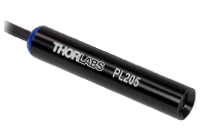 |
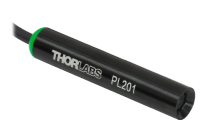 |
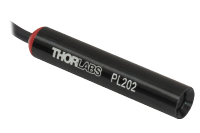 |
| Item # | PL205 | PL201 | PL202 |
| Wavelength (Typical) | 405 nm | 520 nm | 635 nm |
| Output Power (Typical) | 0.90 mW | ||
| Laser Safety Class | Class 2 | ||
| Beam Shapea,b |
Round, Ø3 mm (Typical) at 5 cm | ||
| Typical Beam Profiles (Click Icon for Details) |
|||
| Housing Dimensions | Ø11.0 mm x 60.2 mm | ||
| Specifications | |||
| Alternative Laser with Bare Wire Leadsc | PL206 | PL203 | PL204 |
| Typical Lifetime | 1000 hd | ||

| Click Image for Full View | 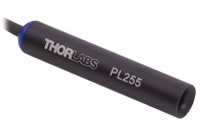 |
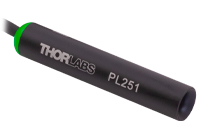 |
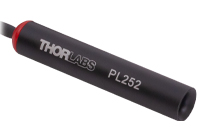 |
| Item # | PL255 | PL251 | PL252 |
| Wavelength (Typical) | 405 nm | 520 nm | 639 nm |
| Output Power (Typical) | 4.5 mW | ||
| Laser Safety Class | Class 3R | ||
| Beam Shapea,b |
Round, Ø3 mm (Typical) at 5 cm | ||
| Typical Beam Profiles (Click Icon for Details) |
|||
| Housing Dimensions | Ø11.0 mm x 60.2 mm | ||
| Specifications | |||
| Alternative Laser with Bare Wire Leadsc | PL256 | PL253 | PL254 |
| Typical Lifetime | 1000 hd | ||

These adapters mount the laser diode housing into SM1 (1.035"-40) lens tubes, 30 mm cage systems, Ø1/2" posts, or Ø1/2" or Ø1" mounts. Please see the application photos in the Overview tab for examples.
The KAD11F and KAD11NT adapters provide ±6° of pitch and yaw adjustment. Two 80 TPI fine adjustment screws on the front plate of the adapter control the pitch and yaw position and can be turned using a 5/64" (2.0 mm) hex key.
| Click Image to Enlarge |  |
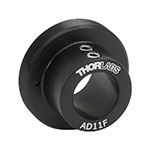 |
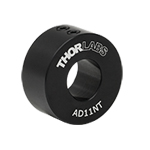 |
 |
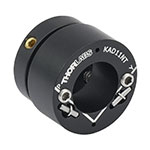 |
| Item # | AD11BA | AD11F | AD11NT | KAD11F | KAD11NT |
| Description | Unthreaded Adapter with a 1/2" Outer Diameter | Externally SM1-Threaded Adapter |
Unthreaded Adapter with a 1" Outer Diameter | Externally SM1-Threaded Kinematic Adapter with Pitch and Yaw Adjustment |
Unthreaded Kinematic Adapter with a 1" Outer Diameter and Pitch and Yaw Adjustment |
| Diode Module Housing Diameter | 11 mm | ||||

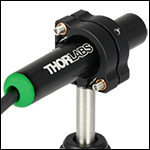
Click to Enlarge
PL201 USB Laser Module Mounted in a MK11F Mini-Series Kinematic Mount
- Securely Mount Ø11 mm Laser Diode Modules
- Angular Range: ±4°
- Compact Nominal Footprint: 0.79" x 0.52" (20.0 mm x 13.3 mm)
- Resolution: 13 mrad (0.77°) per Revolution via Two M2.5 x 0.20 Precision Adjusters
- 4-40 (M3) Mounting Holes Allow for Left- or Right-Handed Orientation
Thorlabs' Mini-Series Kinematic Mount for Cylindrical Components is our most compact solution for mounting the Ø11 mm laser diode modules sold above. This two-adjuster kinematic mount features a nominal 0.79" x 0.52" (20.0 mm x 13.2 mm) footprint, which is the same as our Mini-Series kinematic mirror mounts. Cylindrical components are secured at three points using a nylon-tipped locking screw and a double-bored mounting hole. Both the nylon-tipped setscrew and the two M2.5 x 0.20 adjuster screws accept a 0.050" (1.3 mm) hex key (not included).
For ease of adjustment, we recommend using the 0.050" hex key thumbscrews. We also offer a locking collar and spanner wrench for locking the adjuster screws in a desired position or for creating a hard stop.

| Mounting Kit Components | ||
|---|---|---|
| Item # | PLK1 | PLK1/M |
| Laser Module Mounting Adapter | AD11Fa | AD11Fb |
| Kinematic Mirror Mount | KM100T | |
| Ø1/2" Post | TR3 | TR75/M |
| Ø1/2" Post Holder | PH3 | PH75/M |
| Mounting Base | BA2 | BA2/M |
| Power Supply | DS5 | |
- Includes All Necessary Mounting Hardware
- Compatible with Our PL Series Laser Modules
- DS5 Power Supply Included
These Laser Module Mounting Kits contain all of the components needed to mount and power our PL series laser modules. A region-specific adapter plug is shipped with the DS5 power supply unit based on your location. Please see the table to the right for a list of components included in each mounting kit. For alternate mounting options, please see our selection of mounting adapters above (adapters compatible with this kit must be externally SM1 threaded). For individual power supplies, including a 5 VDC external battery pack, see below.

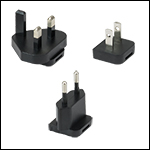
Click for Details
Region-Specific Adapters for DS5
- 5 VDC Regulated Power Supply
- USB Type-A Port
- Compatible with Our USB-Powered Laser Modules
The DS5 is a 5 V, 2 A regulated power supply with a USB Type-A female port. It can be used with any USB-compatible device that accepts a 5 VDC output, and is directly compatible with our USB-powered laser modules. A region-specific adapter plug is shipped with the DS5 power supply unit based on your location.

- USB 2.0 Extension Cables
- Type-A Female to Type-A Male Connectors
- 28-Gauge Conductors
- Various Lengths Available
These USB 2.0 Type-A black extension cables come in various lengths. The use of a USB extension cable can provide additional cable length for our USB-powered laser modules if the included 63" (1.6 m) cable is insufficient. A USB extension cable may also be used to reposition the on/off switch that is part of the USB housing of our laser modules. In addition, the USB Type-A male connection of the extension cable is slimmer than the USB housing of our laser modules, which may allow the laser modules to be powered in more confined USB port areas.

- Portable USB Battery Pack with 5 VDC and up to 2 A Output
- Compatible with CPS Laser Modules and USB-Powered Devices
- 10 000 mAh Capacity
Thorlabs offers the CPS1 Battery Pack for powering our CPS laser modules and other USB-powered devices. The CPS1 battery pack outputs 5 VDC at up to 2 A, and offers 10 000 mAh capacity. A fully charged CPS1 battery pack can power any CPS laser module for at least 36 hours of continuous operation. The pack includes a USB-to-Micro-USB cable for charging and a custom USB-to-Phono cable for powering the CPS laser module. To activate the battery, simply push the power button once. The pack may be charged using standard 5 V USB chargers for portable devices or using a computer USB port. While the battery pack is charging, it can still supply power to an attached laser module.
The CPS1 Battery Pack also includes an LED flashlight adjacent to the micro-USB port. The flashlight is activated and deactivated by holding the power for two seconds.
When connecting the CPS Diode Module, the module and adapter should be connected first. Then the adapter cable should be plugged into the isolated power supply to avoid a short circuit in the phono jack. Please note that the USB adapter included with this battery pack is not intended to be used with power supplies that are not current-limited or isolated from ground, such as some computers or laptops.
 Products Home
Products Home
















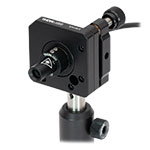
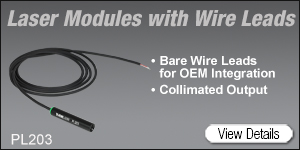
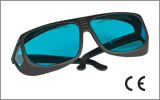
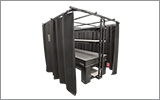
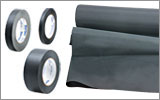
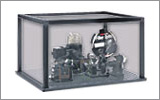
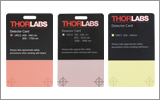
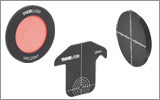
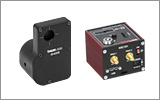
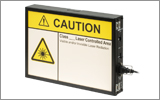



 Zoom
Zoom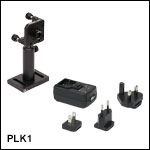

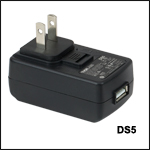



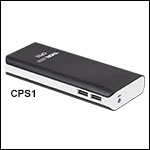
 Compact Laser Modules with USB
Compact Laser Modules with USB